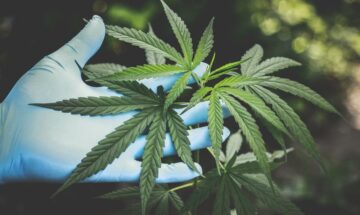
- According to a 2019 study from the Online Journal of Complementary and Alternative Medicine, CBD’s anti-inflammatory and pain-relieving properties may help with specific menstrual discomforts, such as lower abdominal cramps and low back pain(1).
- Cannabidiol (CBD) may be an alternative remedy for dysmenorrhea and other premenstrual syndromes (PMS), such as headaches and mood swings(2).
- CBD may prevent prostaglandin production. Cannabidiol is known to inhibit cyclooxygenase-2 (COX-2) over cyclooxygenase-1 (COX-1), which means it may be promising as an anti-inflammatory and help with pain relief(3).
- A 2014 study from Epidemiologic Reviews noted that dysmenorrhea’s prevalence among women of reproductive age ranges from 16% to 19%, with severe pain in 2% to 29%(4).
See the Best CBD Oil for Menstrual Cramps in 2022
Does CBD Help With Menstrual Cramps?
Cannabidiol is one of the active phytocannabinoids of Cannabis sativa. Although CBD is a non-psychoactive cannabinoid, it still exerts numerous beneficial pharmacological effects, including antioxidant and anti-inflammatory properties(5).
CBD works with the body’s endocannabinoid system (ECS). The ECS is responsible for regulating inflammation and pain(6).
The ECS has two types of cannabinoid receptors, namely CB1 and CB2. These cannabinoid receptors are located in different parts of the body. CB1 receptors are prominently found in the central nervous system, while CB2 is found on cells in the immune system(7).
Endocannabinoids are types of cannabinoids naturally produced by the body. They activate those receptors and fasten to them to work with pain reduction and inflammation(8).
CBD is a primary component of medical marijuana. However, the compound is derived from the hemp plant or is manufactured in a laboratory(9).
What Are Menstrual Cramps?
Menstrual cramps or dysmenorrhea are throbbing pains in the lower abdomen. Many women experience such a condition before and during their menstrual cycle(10).
Some women endure severe menstrual cramps that can interfere with everyday activities for a few days(11).
Research suggests that dysmenorrhea is the leading cause of absence from work and school among women of reproductive age. Menstrual cramps may also be a risk factor for other chronic pain conditions(12).
The Benefits of Using CBD for Menstrual Cramps
There is no published research on using CBD for menstrual cramps. However, its anti-inflammatory and pain-relieving effects could possibly help alleviate period pains.
Dysmenorrhea or menstrual cramps are caused by the release of prostaglandins (PGs) and may be caused by external factors like stress(13). PGs are a class of lipids that control several operations in the body, particularly the healing process(14).
Prostaglandins also play a significant role in various processes of the female reproductive system. These hormone-like substances are involved in control of ovulation and trigger muscle contractions that cause menstrual pain(15).
Prostaglandins can make pain-perceiving nerves hypersensitive. CBD and tetrahydrocannabinol (THC) may help desensitize these nerves. Both cannabinoids may target nerve receptors, such as TRPV1 (transient receptor potential cation channel subfamily V member 1) and CB1, to reduce pain sensation(16).
Cramping during menstruation is made worse by contractions of the muscle that lines the uterus. CBD and THC may function as a relaxant to smooth muscle cells (17).
A 2016 open-label study examined the long-term effect of medicinal cannabis treatment on pain. After the treatment, 274 participants reported improved pain(18).
The results also suggested the long-term benefit of cannabis treatment. However, the findings are exclusive in this group of patients(19).
Standard Therapies for Menstrual Cramps
Painkillers like naproxen and ibuprofen, which belong to a group of medications called non-steroidal anti-inflammatory drugs (NSAIDs), are effective treatments for menstrual pain(20).
These medications can relieve menstrual cramps by reducing the production of prostaglandins(21). Although most women can tolerate NSAIDs, these treatments have side effects, such as stomach-related issues(22).
Meanwhile, birth control pills can relieve menstrual pain by preventing ovulation, reducing PGs’ production(23).
When women use birth control pills, the lining of their womb does not become as thick as usual(24). Therefore, they have a lighter period.
However, birth control pills also have side effects, such as headaches and nausea. Moreover, these pills increase the risk of thrombosis(25). Such a condition happens when blood clots block a person’s blood vessels(26).
Natural Remedies for Menstrual Cramps
Most women commonly experience discomfort around their lower back, abdomen, and thighs when menstruating. Here are a few natural remedies women may try:
Heating Pads
Some evidence suggests that applying warmth onto the abdomen with heat packs relieves painful periods(27). Women may also use heating pads on their lower back for relief during menstruation.
Supplementation With Omega-3 Fatty Acids
A 2012 study from the International Journal of Gynecology and Obstetrics showed that supplementation with omega-3 fatty acids reduced the intensity of primary dysmenorrhea(28).
In a double-blind crossover study, the researchers observed women aged 18 to 22 with primary dysmenorrhea(29).
Women in the first group received one omega-3 capsule daily for three months, followed by a placebo for another three months. Meanwhile, women from group two received a placebo for three months, followed by omega-3 for another three months(30).
As a rescue dose for severe menstrual pains, 400mg of ibuprofen was administered to the participants(31).
After three months of treating the participants with omega-3 fatty acids, the researchers observed a marked reduction in pain intensity(32).
In addition, women supplemented with omega-3 fatty acids required fewer rescue doses than those who received a placebo(33).
A study from the Journal of Nutraceuticals, Functional and Medical Foods showed that hemp seed oil contains omega-6 and omega-3 fatty acids in a 3:1 ratio. The omega-3 found in hemp oil is a much more stable form than fish oil(34).
Magnesium
In a clinical trial, 50 women suffering from primary dysmenorrhea were treated with magnesium. After six months, 21 out of 25 women showed a decline in symptoms, and only four participants reported no therapeutic effect(35).
Acupuncture
Acupuncture is the process of using thin needles to penetrate the skin to treat pain. According to traditional Chinese medicine, acupuncture balances the life force or flow of energy in the body(36).
Although acupuncture has been tested in several studies, it has not been proven effective for pain(37).
Psychological Treatment
Sometimes the pain becomes severe enough that psychological treatment is considered. Medication may include consulting with a psychotherapist and learning methods to reduce pain, such as mindfulness exercises and relaxation(38).
CBD
There is no published research about CBD’s direct effects on menstrual cramps. However, its anti-inflammatory characteristics and pain-relieving properties may help with menstrual discomfort(39).
On the other hand, surgery may be considered if the pain is caused by endometriosis, a condition where the tissue that usually lines inside a woman’s uterus grows outside(40).
When someone has an existing medical condition or any medical concern, it is always best to speak with a doctor regarding pain management before trying alternative treatments.
CBD Ingestion Methods
If a woman considers CBD to help alleviate menstrual pain, there are different methods to take the substance. For instance, she may benefit from CBD through vaping and sublingual administration.
It is worth noting that these methods have different bioavailability rates or the percentage of an administered dose that reaches the target area in the body(41).
Ingesting CBD using a vape pen is the fastest way to benefit from the substance(42). However, the substance may irritate the lungs(43). Meanwhile, sublingual administration, where a person takes the substance under the tongue, is the second-fastest method(44).
CBD products range from full-spectrum CBD oil, tinctures, topicals, and gummies. Consumers may also opt for CBD isolate, which is the pure form of cannabidiol. It is a chemical compound present in the cannabis plant(45).
How to Use CBD for Menstrual Cramps `
Here are a few CBD ingestion methods women may use to manage PMS symptoms and alleviate the pain caused by period cramps:
CBD Topicals
Women may apply CBD topically using CBD oils, lotions, and balms onto the affected area. However, the effects may take a while, as topicals are not absorbed into the entire body compared to other methods(46).
CBD Suppositories
Suppositories are pills, generally in an oval or cone shape specially designed for administering certain medications through vaginal or anal cavities(47).
Vaginal CBD suppositories work like tampons. However, they may be messy. Therefore, women may wear a pad for a little while after placing one inside the vagina.
Self-medication using CBD suppositories may lead to unwanted effects. Therefore, women should openly discuss this method with a doctor experienced in cannabis use.
CBD Dosage to Take for Menstrual Cramps
CBD has not yet been approved by the U.S. Food and Drug Administration (FDA) as a medication. Therefore, there is still no recommended CBD dosage for menstrual pain.
However, if a woman considers CBD for dysmenorrhea, CBD is generally safe to use(48). But they should always talk to their doctor first.
The initial dosage for CBD oil should be low and may be increased gradually until the desired effect is achieved. A standard dose of CBD ranges from 10mg to 100mg daily(49).
However, if women find the standard doses excessive, they may try micro-dosing(50). A microdose ranges from 0.5mg to 20mg of CBD per dose daily(51).
Is CBD Better Than THC for Menstrual Cramps?
Based on a 2018 report from the World Health Organization (WHO), CBD is a controlled substance that has not been fully proven to have severe side effects(52).
Unlike THC, cannabidiol (CBD) is non-psychotic and non-addictive(53). Thus, it may be safe for use even daily.
CBD is also federally legal across the United States(54).
Does CBD Affect Menstrual Cycle?
Findings from a 2019 review hypothesized that CBD could be a viable option for managing menstrual symptoms(55). However, there are no studies on whether CBD may affect the menstrual cycle.
Conclusion
CBD may be a promising chemical compound that is observed for being safe. However, further studies are still recommended to understand the full potential and long-term effects of CBD.
Many CBD brands promote the various health benefits of CBD. However, cannabidiol has yet to be proven to treat menstrual cramps and other PMS symptoms like bloating.
Women’s health and wellness are essential. Therefore, it is highly recommended that women consult their healthcare providers, especially when using CBD for the first time.
In addition, anecdotal evidence about CBD with little science to support the claims proliferates on the internet. Thus, consulting a physician first, preferably with knowledge about cannabis, is essential.
- Is CBD A Viable Option for Menstrual Symptoms?
https://irispublishers.com/ojcam/fulltext/is-cbd-a-viable-option-for-menstrual-symptoms.ID.000548.php - Ibid.
- Cannabidiolic acid as a selective cyclooxygenase-2 inhibitory component in cannabis
https://pubmed.ncbi.nlm.nih.gov/18556441/ - The prevalence and risk factors of dysmenorrhea
https://pubmed.ncbi.nlm.nih.gov/24284871/ - Antioxidative and Anti-Inflammatory Properties of Cannabidiol
https://www.ncbi.nlm.nih.gov/pmc/articles/PMC7023045/ - The role of the endocannabinoid system in female reproductive tissues
https://ovarianresearch.biomedcentral.com/articles/10.1186/s13048-018-0478-9 - A Look at the Endocannabinoid System’s CB1 and CB2 Receptors
https://echoconnection.org/look-endocannabinoid-systems-cb1-cb2-receptors/ - Ibid.
- Cannabidiol (CBD)-what we know and what we don’t
https://www.health.harvard.edu/blog/cannabidiol-cbd-what-we-know-and-what-we-dont-2018082414476 - Menstrual cramps
https://www.mayoclinic.org/diseases-conditions/menstrual-cramps/symptoms-causes/syc-20374938 - Ibid.
- What women say about their dysmenorrhea: a qualitative thematic analysis
https://www.ncbi.nlm.nih.gov/pmc/articles/PMC5833075/ - The Prevalence and Risk Factors of Dysmenorrhea
https://academic.oup.com/epirev/article/36/1/104/566554 - What is Prostaglandins?
https://www.hormone.org/your-health-and-hormones/glands-and-hormones-a-to-z/hormones/prostaglandins - Roles of prostaglandin receptors in female reproduction
https://academic.oup.com/jb/article/157/2/73/2726258 - The endocannabinoid system in pain and inflammation: Its relevance to rheumatic disease
https://www.ncbi.nlm.nih.gov/pmc/articles/PMC5685274/ - Effects of abnormal cannabidiol on oxytocin-induced myometrial contractility
https://rep.bioscientifica.com/view/journals/rep/139/4/783.xml - The Effect of Medicinal Cannabis on Pain and Quality-of-Life Outcomes in Chronic Pain: A Prospective Open-label Study
https://pubmed.ncbi.nlm.nih.gov/26889611/ - Ibid.
- Period pain: Overview
https://www.ncbi.nlm.nih.gov/books/NBK279324/ - Ibid.
- Period pain: Overview
https://www.ncbi.nlm.nih.gov/books/NBK279324/ - Ibid.
- Ibid.
- Thrombosis
https://www.hopkinsmedicine.org/health/conditions-and-diseases/thrombosis - Ibid.
- Period pain: Overview
https://www.ncbi.nlm.nih.gov/books/NBK279324/ - Effect of omega-3 fatty acids on intensity of primary dysmenorrhea
https://pubmed.ncbi.nlm.nih.gov/22261128/ - Ibid.
- Ibid.
- Ibid.
- Ibid.
- Ibid.
- The Composition of Hemp Seed Oil and Its Potential as an Important Source of Nutrition
https://www.tandfonline.com/doi/abs/10.1300/J133v02n04_04 - [Magnesium–a new therapeutic alternative in primary dysmenorrhea]
https://pubmed.ncbi.nlm.nih.gov/2675496/ - Acupuncture
https://www.mayoclinic.org/tests-procedures/acupuncture/about/pac-20392763 - Period pain: Overview
https://www.ncbi.nlm.nih.gov/books/NBK279324/ - Ibid.
- Is CBD A Viable Option for Menstrual Symptoms?
https://irispublishers.com/ojcam/fulltext/is-cbd-a-viable-option-for-menstrual-symptoms.ID.000548.php - Endometriosis
https://www.mayoclinic.org/diseases-conditions/endometriosis/symptoms-causes/syc-20354656 - Drug Bioavailability
https://www.ncbi.nlm.nih.gov/books/NBK557852/ - How to Safely Use CBD: Should You Inhale, Spray, Apply, or Eat It?
https://www.consumerreports.org/cbd/how-to-use-cbd-inhale-spray-apply-eat/ - Is It Safe to Vape CBD?
https://www.consumerreports.org/cbd/is-it-safe-to-vape-cbd/ - Fast Dissolving Sublingual Films of Ondansetron Hydrochloride: Effect of Additives on in vitro Drug Release and Mucosal Permeation
https://www.ncbi.nlm.nih.gov/pmc/articles/PMC2964757/ - Cannabidiol primer for healthcare professionals
https://www.ncbi.nlm.nih.gov/pmc/articles/PMC7340472/ - How to Safely Use CBD: Should You Inhale, Spray, Apply, or Eat It?
https://www.consumerreports.org/cbd/how-to-use-cbd-inhale-spray-apply-eat/ - CBD Suppositories – Complete Overview
https://hemppedia.org/cbd-suppositories/ - An Update on Safety and Side Effects of Cannabidiol: A Review of Clinical Data and Relevant Animal Studies
https://www.ncbi.nlm.nih.gov/pmc/articles/PMC5569602/ - CBD Dosage – How much CBD should I take?
https://hemppedia.org/cbd-dosage/ - Ibid.
- Ibid.
- CANNABIDIOL (CBD)
https://www.who.int/medicines/access/controlled-substances/WHOCBDReportMay2018-2.pdf - Safety and side effects of cannabidiol, a Cannabis sativa constituent
https://pubmed.ncbi.nlm.nih.gov/22129319/ - H.R.2 – Agriculture Improvement Act of 2018
https://www.congress.gov/bill/115th-congress/house-bill/2/text - Is CBD A Viable Option for Menstrual Symptoms?
https://irispublishers.com/ojcam/fulltext/is-cbd-a-viable-option-for-menstrual-symptoms.ID.000548.php




















